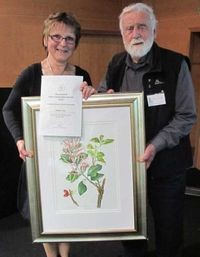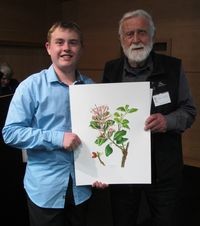A number of people and organisations were recognised for their dedication and exceptional work in protecting our native plants at the 2015 conference.
 Valerie Fay accepting her award from Sir Alan MarkIndividual - Valerie Fay
Valerie Fay accepting her award from Sir Alan MarkIndividual - Valerie Fay
Valerie has been an outstanding volunteer at the Orokonui Ecosanctuary near Dunedin since its inception in 2007. She has been a hard-working and dedicated leader of the volunteer crew that has planted thousands of native plants in the Sanctuary, and has taken a key role in sourcing and propagating many of Otago’s rare and threatened plants that are show-cased in the rare plants garden at the Sanctuary. Valerie has also provided key assistance with the experimental translocation of two threatened plant species – Carex inopinata and Simplicia laxa –into kānuka forest at the Sanctuary, including the twice-yearly monitoring of these new populations.
School Plant Conservation Project - Clyde Primary School
Over the last 5 years, students from Clyde Primary School have made a tremendous contribution towards Project Gold’s native restoration plantings along the Millennium River Track in Clyde. The area has been transformed from an overgrown, weedy riverbank into an amazing native walkway as a result of the effort and dedication shown by staff and students from the school, as well as by members of the local community.
Local Authority Protecting Native Plants - Porirua City Council for Bothamley Park
Over the last 10 years, Porirua City Council has done an outstanding job of transforming Bothamley Park in Porirua from a weed-infested area into a well-used and appreciated public space, with much improved ecological values. The Council has undertaken a great amount of weed control in the park, and restored weedy areas by planting a wide variety of native species, including some rare and threatened species such as Streblus banksii (At Risk-Relict). The Council has also encouraged public involvement, with well-attended regular community planting days, and people are now starting to take ownership of the park and look after their ‘patch’, including removing rubbish.
 Keagan Maynard receiving his award from Sir Alan MarkYoung Plant Conservationist of the Year - Keagan Maynard
Keagan Maynard receiving his award from Sir Alan MarkYoung Plant Conservationist of the Year - Keagan Maynard
Keagan is a Year 9 student from Fiordland College in Te Anau. He has been an enthusiastic and committed volunteer for several conservation projects in the Te Anau area over the last few years. He has been involved in seed collecting and restoration planting in the Kids Restore the Kepler project, and advocated for sensitive design to protect native plant species during construction of a bike track on the school grounds. Keagan has also shown himself to be a strong leader, helping to mentor and inspire other students to get involved in conservation.
Special Award - NZ Transport Authority for the Whangarei State Highway Gateway Project in Northland
The NZ Transport Authority (NZTA) is committed to utilising native plant species in state highway corridors for both functional purposes, such as erosion control and slope stabilisation, and for ecological restoration. NZTA has made an important contribution to native plant conservation in the Northland region through its use of native plants in the Whangarei State Highway Gateway Project. In particular, the focus on threatened and uncommon Northland plants, such as Coprosma neglecta, Metrosideros carminea, Pittosporum obcordatum, Planchonella costata, and Tecomanthe speciosa in these highly visible public transport corridors will help to raise the profile of these lesser-known species and encourage them to be more widely planted.
Plant Nursery involved in Plant Conservation - Mainly Natives Plant Nursery
Mainly Natives Plant Nursery, through its owner Georgina Pahl, has made an important contribution towards restoration of native plant communities in the Nelson-Tasman region through its involvement in a wide range of planting projects, both public and private. Georgina is an enthusiastic and committed nurserywoman who has gone the extra mile to ensure that planting projects are successfully planned and implemented. The nursery is actively involved in and promotes the propagation and planting of locally rare and threatened species (e.g. leafless pōhuehue, narrow-leaved maire, Pittosporum obcordatum and Carmichaelia australis var. flagelliformis), which will help to ensure that these species survive in the Nelson-Tasman area, and to raise their profile in the community.
